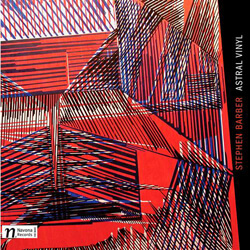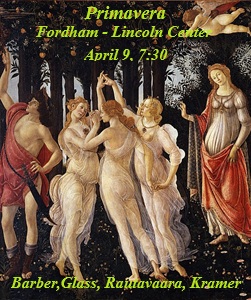 Astral Vinyl is an album of new works by Texan composer Stephen Barber released in May of this year by Navona Records. It fits squarely within the burgeoning “New Synthetist” movement of contemporary art music, in that elements of many different genres can be heard throughout the album, often within the same track. The diversity of sonorities makes it difficult to generalize about the album’s content: most of the pieces are emotionally direct, with clear and memorable melodies drawing on the folk and popular traditions, but there are moments of disquieting and elusive subtlety as well that seem to originate in the more abstract realms of 20th century classical music thought.
Astral Vinyl is an album of new works by Texan composer Stephen Barber released in May of this year by Navona Records. It fits squarely within the burgeoning “New Synthetist” movement of contemporary art music, in that elements of many different genres can be heard throughout the album, often within the same track. The diversity of sonorities makes it difficult to generalize about the album’s content: most of the pieces are emotionally direct, with clear and memorable melodies drawing on the folk and popular traditions, but there are moments of disquieting and elusive subtlety as well that seem to originate in the more abstract realms of 20th century classical music thought.
The most striking example of the bold and direct aspects of Barber’s writing are found in the rousing, muscular, almost martial strains of Conversatio Morum I. It begins with a memorable melodic “hook,” undergirded by a strong eighth-note pulse in the low strings, which, when it ends, is replaced by a drum tattoo. The main theme undergoes a great deal of melodic and harmonic development, showing off Barber’s mastery of both traditional and contemporary tonal idioms. In the middle, there is a brief contrasting theme introduced by the piano, which sounds like nothing so much as a journey or heroic tale. A dissonant transitional section, supported by an off-beat pizzicato string rhythm and a constant drumbeat, follows. When modified versions of the main theme are reintroduced, new sounds of chiming percussion support them. A strong descending flourish concludes this forceful but beautiful work.
However, the album both begins and ends with more nuanced fare. Chanson Rond Point is a very short work for string quartet featuring a quiet but insistent Baroque-like melodic idea that is passed from instrument to instrument. It begins in an extremely high register and at a quiet dynamic. As the melody moves down the registers, the piece grows slightly in volume, but once it reaches the middle register, well… it doesn’t conclude so much as simply stop, as if the theme suddenly grows tired of iterating itself and decides to throw itself to the ground.
Meanwhile, The Killing, the album’s final track, is a somber work. Its dour, slow-moving lines evoke clouds, rain, and mud. (Although as far as I was able to determine, this piece is not connected to the AMC show of the same name, it would fit the bleary Seattle murder mystery perfectly.) The occasional sudden violent outbursts of flurrying violins are just individual moments of energy, not transitions to faster or more upbeat material; the tone is remarkably consistent throughout. There is tension along with the grimness, provided by dissonant chords as well as some rapid repeated dyads in the strings. The final section contains some almost-major harmonies that hint at the possibility of being lifted up from the mire, but the final chord, while forceful, is definitely not happy: The Killing is a harsh closing statement to a powerful album.
The most multi-genre work is the ambitious yet gentle Elvis and Annabelle. The first movement is a mild, saxophone-led lullaby, with a light rock beat backing. Splashes of dissonant, off-kilter modernist fragments interrupt the smooth harmonic progression, but ultimately do not derail it, rather turning into a complementary element. The second movement begins similarly sweetly, but at times is dark and stormy; it is noticeably without a drumbeat, and so, despite the similarity of tone and length with the first movement, it comes across convincingly as a slow contrasting section. Finally, we are treated to the shorter, more upbeat, jazzier third movement, featuring a bright but jagged saxophone melody, a reinvigorated percussion section, featuring glockenspiel and xylophone as well as drum set, and a plucked walking bass line. The dissonant jazz harmonies are interspersed with richer classical ones, leading to a stunningly warm, vibrant finale.
There are four different performing ensembles featured on the album: the Tosca String Quartet on the stand-alone works Chanson Rond Point, String Quartet No. 1, and Les Mots, the American Repertory Ensemble on the two movement Conversatio Morum as well as the final track The Killing, the Boiler Makers on the three movement Elvis and Annabelle, and the Meridian Arts Ensemble on Multiple Points of View of a Fanfare (two movements). Additionally, the gorgeous art song Marbles features Barber himself on piano along with soprano Lucy Schaufer and percussionist Darren Dyke on steel drums.
Speaking of the different ensembles, I must mention the one aspect to the presentation of the music that did not work well for me, which was the decision to split up the three multi-movement pieces. On the one hand, when listening to the album straight through, it can come as a nice surprise to hear themes or instruments from a few tracks back. However, having them interspersed with each other and with the stand-alone pieces causes a loss of much of their potential thematic unity. Isn’t the whole point of a multi-movement work that it’s one piece in several sections? And yes, I understand that in the modern era, musicians can and should “think outside the box” and challenge their own and listeners’ assumptions about all aspects of music. However, this particular break with tradition did not feel like it fit well with Astral Vinyl’s overall vibe.
The Astral Vinyl CD includes an “enhanced content” portion that can be launched when the CD is inserted into a computer. Most of the multimedia extras are essentially promotional in nature: cell phone ringtones, links to other works in the Navona catalog, and that of Navona’s parent PARMA. There is also biographical information on the composer, and on the artist who drew the cover art for the album—data easily accessible on those individuals’ websites with a few seconds of Googling. More interestingly, there are jpg files of some of the pieces’ scores. However, while it was interesting to see them, especially the two that are hand-written, the images are very small and cannot be zoomed, making them less than ideal for “enhancing” even an educated listener’s understanding of the material. (I tried importing the files to my hard drive and opening them in Preview, which did allow me to zoom in, but they were extremely blurry.) The extra content felt more gimmicky than engaging.
In spite of this one small flaw—it’s easy enough to reorder the tracks on iTunes, after all—Astral Vinyl is an incredible album. Barber covers more ground on this disc, genre-wise, than many musicians do in their entire careers. Catchy and by turns moody and exhilarating, it can be approached on many levels, and will reward repeated listens.
Stephen Barber, Astral Vinyl (Navona Records, NV5850) – Buy on Amazon
—
Matt Weber is a New York based composer, educator, and political slacktivist.









